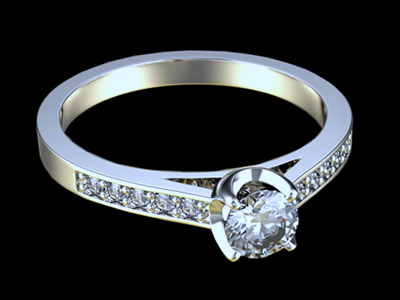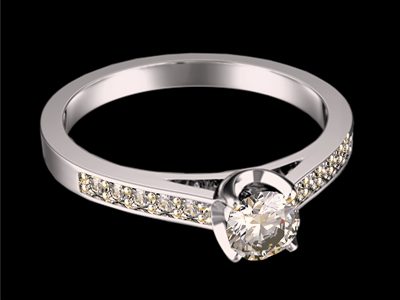Jewellery comes in a wide variety of metal types. When searching for what suits you best, a lot of considerations need to be taken into account. Your budget plays a major role, along with how, when and where you are going to use it. We have all heard of the common metals, like gold, silver, platinum, etc. But there are many more that are available in the market today, that have helped lower the final price of a jewellery product.
Below, you will find a list of the metals used for the jewellery available on this website. We have a huge selection of jewellery with different metal components. It is advisable to check the individual product page for finer details about the individual product. Here we give you a generalized version of what the metal constitutes and a few of its important properties.

YELLOW GOLD
Gold is one of the most popular metals for investment. Compared to other metals, it is less chemically reactive. It is shiny, soft and dense and thus tends to bend easily in jewellery made with high concentrations of gold in it. Gold does not tarnish or corrode. It is seen as a symbol of wealth. The amount of gold in various alloys is measured in carats (k). Pure gold is 24k. In its pure form, it is bright, slightly reddish- yellow in colour. Gold mixed with other alloys, like silver, copper etc., are seen to have 9k, 14k, 18k gold in them. Although since the last 100 years, South Africa was the largest producer of the metal; in recent times, China seems to have taken over.

YELLOW GOLD FILLED
Yellow Gold Filled jewellery has a solid layer of real yellow gold. Heat- and pressure is used in bonding this thin layer of karat gold to a brass (or other base metal) core. This layer constitutes atleast 5% of the total weight of the item. This makes the jewellery more durable and it will not chip easily too. It is safer for individuals with metal allergies to use a product made this way. It is more expensive than plated jewellery, which has a lesser gold content in them. Gold-filled items are 5 to 10 times thicker than regular gold plated ones, and 15 to 25 times thicker than gold electroplated items.

YELLOW GOLD PLATED
In gold plated jewellery a very very thin layer of gold is deposited on the surface of another metal. Most often the base metal would be copper or silver. Yellow Gold plated jewellery has an attractive finish and looks like real gold jewellery. It is relatively strong and durable as it is normally plated over a stronger metal. It is also much more affordable than pure gold or gold filled jewellery. Care should be taken to avoid wearing such jewellery in places where it could get scratched, chipped or come in direct contact with chemicals, or water.

WHITE GOLD
This is an alloy of gold and atleast one white metal. These white metals could be nickle, manganese or palladium. Sometimes, copper, zinc or silver may also be added to it. In order to protect this combination of metals, the final product is normally plated with a hard metal called rhodium. Although rhodium may wear off over a period of time, it can be easily re-plated to give it its shine again. Without the rhodium finish, white gold could appear dull grey, light brown or even a pale pink. This is a popular alternative to yellow gold, silver and platinum jewellery.

WHITE GOLD FILLED
White Gold Filled jewellery has a thick layer of white gold over a base metal alloy. Its the next quality alternative to sold white gold. A layer of white gold is pressure bonded to the base metal. It is much more valuable than white gold plated jewellery. Unlike gold plated jewelry, gold filled jewelry has a commonly measurable amount of actual gold in it. This jewellery is normally plated with rhodium as a finishing touch, to give it durability and shine.

WHITE GOLD PLATED
In white gold plated jewellery, the main base metal of the jewellery is made with an alloy of other metals, and it is than given a very thin, almost microscopic film of white gold by electroplating it. Some people also refer to gold plated jewellery as gold-overlay. The most important benefit of these jewellery pieces, is that they tend to be very strong. Pure gold is generally a soft metal, and is highly susceptible to nicks, dents and bending. Jewellery made this way has an attractive and shiny finish, while also being sturdy and durable at the same time. This jewellery is also much more affordable than real gold jewellery.

ROSE GOLD
Gold comes in various colours. One such colour is called Rose Gold. It is also known as " Pink Gold" or " Red Gold". It is a combination of two alloys , gold and copper. Although, the names are often used interchangeably, these colours are dependent on the amount of copper present along with the gold. The more the copper used, the more darker red the gold will be. Crown gold which is the highest version of rose gold is 22 karat. Eighteen karat red gold may be made of 25% copper and 75% gold. For 18 karat rose gold, typically about 4% silver is added to 75% gold and 21% copper to give a rose color. In the Middle East, 14 karat red gold is often found to contain 41.67% copper.

ROSE GOLD PLATED
Rose Gold plated jewellery is one in which the jewellery is covered with a fine finish of Rose Gold. It produces a bright and clean finish to the jewellery piece and help protect the base metal to some extent to. The amount of contact the jewellery has, the thickness of the plating and the base metal type, are all determinant factors on how well and how long this plating will last. It has been seen that this gold is gaining more popularity in the 21st century and is commonly used in rings, earrings, bracelets and other jewellery. We also find that nowadays, red gold plated finish being used in mobile phones, to make them look sleek and beautiful.

GOLD VERMEIL
Gold Vermeil is a combination of sterling silver and gold. Typically, it is sterling silver jewellery coated with 14k or 24 k gold. To be considered vermeil, the gold must be at least 10 karat (42%) and be at least 2.5 micrometers thick. Vermeil pieces look like gold, but are much cheaper and lighter than solid gold. Vermeil is produced either by fire-gilding or electrolysis. Vermeil is seen many a times in the making of cutlery and other tableware.

PLATINUM PLATED
When jewellery is plated with a thin layer of platinum, it is known as platinum plated jewellery. Platinum is seen to have a luster that is much more purer than silver or gold. This enhances the brilliance of diamonds and other gemstones. It also does not tarnish easily; and is seen to be hypoallergenic in nature, meaning; not many people suffer from allergic reactions to it. Platinum can be plated over gold, silver and even other softer metals used in jewellery making. Platinum plating is also used on many other everyday products like, watches, stationery etc; because of its shine and elegance.

STERLING SILVER
Real Silver or fine silver is 99.9% pure silver. It is very soft in nature and thus makes it difficult to produce anything that will keep its shape. It is thus seen, that silver is mixed with other metal alloys like copper to give it strength, and preserve its ductility and appearance. Sometimes, other metals may be used to replace copper, depending on what product is being made and the intention of what properties are required to make the final product. Sterling silver is an alloy of silver containing 92.5% by weight of silver and 7.5% by weight of other metals, usually copper. The sterling silver standard has a minimum fineness of 925. Jewellery made of sterling silver is seen to be shiny, bright, not as reactive and doesn't tarnish easily.

RHODIUM PLATED STERLING SILVER
Rhodium is a silver white metal related to the platinum family. It is considered to be best in its class of all metals in the platinum family as it is the most tarnish and corrosion resistant of them all. Rhodium plated silver is fine or sterling silver that has been polished and dipped in rhodium. It is bright, shiny and so reflective, that it is used while making mirrors too. Through electroplating it is applied to jewellery as a thin coat, to protect it further. If an original coating of .25 microns has been applied, replating may not be necessary for quite some time.

SILVER PLATED
Silver plating refers to the process of covering a conductive surface with silver to prevent it from corrosion while also adding a lustrous shine to it at the same time. There are various types of silver plating methods available: from matte, semi-bright to bright. While some plating may be done with chromate, others may not make use of it. Pure silver plating is also very much possible. Silver plating in jewellery adds a perfect polish to the surface of it, making it shine. It helps in inhibiting corrosion, hardening the surface, reducing friction and also provides a shield against radiation. Proper care should be taken for parts exposed to high humidity, since any porous or cracked silver layer can cause rapid corrosion of the underlying metal.

STAINLESS STEEL
Stainless steel is a steel alloy with a minimum of 10.5% chromium content by mass. It does not corrode, stain or rust with the presence of water or in high humid conditions. There are over 150 grades and surface finishes of stainless steel, and are used based on what best suits the environment the alloy must endure. In jewellery and watches, the 316L grade is commonly used. This grade does not turn black and can be re-finished by any jeweler. This metal is used in various other applications and is 100% recyclable. It is fairly common these days to find wedding bands made of steel, because of its high end look, and affordability. Being highly durable, this metal is also known to stand the test of time.
These are some of the few metal types that are the most prominent ones available in the market today. Besides these there are various combinations of metals that are used to create inspiring modern artisanal jewellery. As we go deeper into their making and the respective cultures from which they emerge; we find the essence of undying creativity and a plethora of options to choose from.
At Carat Infini, we do our best, to give you the last word, in what you seek. We give you the choice of a wide variety of metal types to suit your style and budget. We hope, your search for whatever jewellery you are looking for, ends right here -on our website.






































